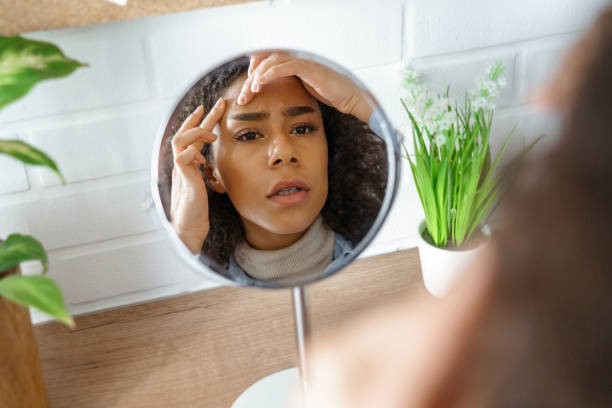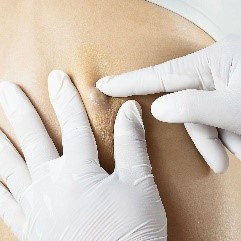AN-Guide de route
Acne Roadmap

Simply put: acne occurs when sebum (the oil that naturally lubricates our skin) mixes with dead skin cells and bacteria and clogs your pores. People with acne have abnormal loss of the cells that line their hair follicles and hyperproduction of sebum, and both of these factors lead to clogged pores.
Acne is generally divided into two main categories, non-inflammatory and inflammatory acne, and within these sub-groups you will find all different types with different recognisable characteristics.
With this type of acne, also called comedonal acne, you won’t find large red pimples. Instead, you’ll see small black and whiteheads, usually where your face is more oily, such as the T-zone (but also your chest and back). This type of acne is caused by the clogging of the pilosebaceous units (hair follicles) of the skin.
Now, the difference between white- and blackheads:
- Whiteheads: Also known as closed comedones, this type appears as small white bumps due to trapped dead skin cells and sebum. Whiteheads are covered by a thin layer of skin and the contents are not exposed to the air, so they appear white or yellowish, which is the default colour of oil and dead skin cells.
- Blackheads: In contrast, this type is best described as open comedones that expose trapped oil and dead skin cells to the air. Oxygen from the air reacts with the trapped substances and oxidation occurs, turning the pimple black.
Inflammatory acne is often caused by an overgrowth of a bacterium that lives on the skin called P. acnes which increases inflammation. This type of acne can appear as papules, pustules, nodules and cysts.
Papules: these are tender bumps with redness and swelling that have no visible fluid and are usually less than 5 mm in size. Papules are often caused by dead skin cells clogging the pores and increasing inflammation.

Pustules: these are inflamed lesions with a visible white spot which may be tempting to squeeze (but it is a good idea not to). They are usually 1-5 mm raised. Pustules are often caused by the overgrowth of P. acnes bacteria.

Nodules: When you think of a nodule, think of large, firm, red bumps. These extend deeper than a papule and are notoriously painful.

Cysts: Another painful form of inflammatory acne, cysts are a form of deep acne under the skin that seems to take forever to clear. They are like highly inflamed and/or draining acne nodules. Cysts can have a more genetic or hormonal origin.

The cause of all acne is multifactorial, which means that genetics, bacteria, hormones, stress and diet can all play a role to varying degrees. For this reason, a holistic approach to acne treatment takes all these factors into account. While you may not have much control over some of the underlying causes, there are a few ways to change your routine and treat others.
- A balanced and healthy diet and lifestyle will benefit your overall health and your skin.
- In addition, not cleansing your face at night can also lead to breakouts.
- Learn to manage your stress levels.
- Exfoliate:
The most effective way to treat and prevent blackheads is to use products that normalize cell shedding, break down oil and gently exfoliate dead skin cells from the stratum corneum above our epidermis.
But keep in mind that acne treatment is a marathon, not a sprint; in other words, start low (ingredient percentage and frequency) and go slow. Be patient and allow 6-8 weeks to really let your products transform your skin.
Consider products with gentler exfoliants, such as azelaic acid, mandelic acid, retinoids or botanical bakuchiol as an alternative to retinol.
Consult your doctor before using retinoids if you are pregnant, breastfeeding or planning to become pregnant.
- Moisturize
Acne sufferers usually fear that a moisturiser will clog their pores and cause acne, but this is not the case. Moisturising is key. Using an oil-free or non-comedogenic formula may actually help you tolerate your acne skin products better for faster results. A light serum with hyaluronic acid might be a good option too.
- Try topical antibacterial and anti-inflammatory ingredients for inflammatory acne
The Cutibacterium acnes bacteria live at the base of your hair follicles and break down your sebum into fatty acids, which in turn activate inflammation in the surrounding skin.
So while acne is not a true infection of your skin, antibacterial products are a mainstay of inflammatory acne treatment.
Look for benzoyl peroxide, which will kill bacteria and thus decrease the inflammation caused by bacteria. Or an antimicrobial cleanser that contains sodium hypochlorite as an alternative to benzoyl peroxide. Also look for topical anti-inflammatory ingredients, such as niacinamide, zinc and sulphur.
- Make an appointment with your dermatologist
Not all acne can or should be treated at home; cysts and nodules that are deeper in the skin may require a visit to your dermatologist. Sometimes prescription topicals, a cortisone injection or even an incision and drainage are required.
